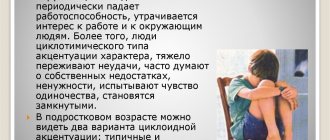Concept
The concept of “accented personality” was introduced by the German psychiatrist and psychopathologist Karl Leonhard. His classification of personalities had much in common with the concept of “latent psychopathy,” previously proposed by the Soviet scientist Pyotr Gannushkin. However, it was developed by Leonhard into an independent theory.
The scientist presented his thoughts on character typology in his work “Accented Personalities.” The first part of the monograph provides a classification and analysis of various accentuations; in the second, accentuated types are examined using the example of heroes from classical works of world literature.
Although, according to the International Classification of Diseases ICD-10, accentuated personality traits are included in the list of problems associated with difficulties in organizing a normal lifestyle (class 21/item Z73.1), the presence of accentuation does not equate to a mental disorder!
At first glance, character accentuations according to Leonhard are similar to personality disorders, which leads to the assumption that there is a connection between them. However, the scientist only sought to identify those personality traits that bring difficulties to their owners in life. When describing accentuations, Leonhard turned to the negative manifestations of certain character traits in an extreme, most pronounced form. Therefore, his characterization of psychological types is perceived as an illustration of human shortcomings and painful patterns of behavior. However, accentuations according to Leonhard are still a manifestation of the clinical norm, albeit in a more acute form, and therefore cannot be used as a psychiatric diagnosis.
Psychologists and psychotherapists around the world are actively interested in issues of accentuation, since the disproportionate development of certain personality traits creates conditions for the formation of corresponding mental or psychosomatic disorders.
In Russian psychology, Leonhard’s typology was developed and supplemented by the scientist Andrei Lichko, who changed the original term “accentuated personality” to “accentuation of character.” After all, an accentuated personality, according to the Soviet psychiatrist, is too complex a concept, more consistent with the idea of psychopathy.
Correspondence table of accentuations according to Leonhard and Lichko.
| № p/p | K. Leongard (questionnaire by H. Smishek) | A.E.Lichko (PDO questionnaire) |
| 1. | – | Astheno-neurotic |
| 2. | Dysthymic | – |
| 3. | Demonstrative | Hysterical |
| 4. | – | Unstable |
| 5. | Stuck | – |
| 6. | Pedantic | Psychasthenic |
| 7. | – | Schizoid |
| 8. | Hyperthymic | Hyperthymic |
| 9. | – | – |
| 10. | Excitable | Epileptoid |
| 11. | Anxious-fearful | Sensitive |
| 12. | Cyclothymic | Cycloid |
| 13. | Affectively exalted | Labile hysteroid |
| 14. | Emotive | Labile |
| 15. | – | Conformal |
| Total | 10 | 12 |
What is the Leonhard Schmisek questionnaire?
This test is designed to identify the type of accentuation of character and temperament; it belongs to the typological approach to the study of personality. The technique is a modification of the work of K. Leongard “Methods for studying personality accentuations.”
Accentuation is a strong manifestation, much more along with others, of individual personality traits that are inherent in every person. Such manifestations lie between normality and psychopathy. Accented characteristics in society can manifest themselves both positively and negatively. When exposed to harmful factors, accentuations can develop into pathology and destroy the structure of the personality. The test offers eighty-eight questions that must be answered “yes” or “no.” You can take Leonhard Schmishek's questionnaire on our website and find out the properties of your character and temperament.
Types of accentuations
Types of temperament and character accentuation according to Leonard are divided into separate groups.
Temperament
The scientist attributed six types of accentuations to temperament, as a biologically determined formation. Let's talk briefly about each of them.
- Hyperthymic (hypomanic) temperament. Characterized by a predominance of an optimistic mood, a thirst for activity, a focus on success, and sociability. Negativity develops superficiality, an inability to complete a task. There is a violation of ethical standards, a waste of opportunities.
- Dysthymic type (subdepressive). The opposite of hyperthymic. Characterized by an orientation toward failure, pessimism, a serious ethical position, extreme passivity in action, and lethargy.
- Affectively labile type (cyclomic). It is characterized by frequent changes in hyperthymic and dysthymic states.
- Anxious. Characterized by the inability to defend one's point of view in a dispute, fearfulness, timidity, wariness, humility, and a humiliated position. Compensation in the form of feigned self-confidence or even impudent behavior is possible.
- The affectively-exalted type is distinguished by the intensity of experiences, violent emotional reactions, and a tendency to extreme manifestations of feelings (enthusiasm, despair). Easily charged by the mood of others.
- The emotive type is characterized by the ability to deeply feel and empathize. He is distinguished by his impressionability, kindness, and compassion.
Character
Leonhard's character classification is represented by four types.
- Demonstrative (hysterical) type. The peculiarity of accentuation is the hypertrophied tendency to repression. This explains the ability of the hysteric to embellish reality. A person, as it were, enters into the desired image, beginning to believe his fantasies. Thanks to this trait, he easily adapts to his environment, instilling in himself a feeling of love and sympathy for others. The notorious “need for recognition,” as one of the motives of the demonstrative type, is exaggerated. Rather, the passion for self-praise is associated with the ability to repress objective information about oneself. For an ordinary person, if he wants to embellish the real state of things, the brakes are turned on. A hysteric person tends to forget himself, which often leads to rash actions.
- Pedantic character. In contrast to the demonstrative type, the repression mechanism is poorly developed. People with this type of personality are not able to repress doubts or discard unimportant details of the issue, so they can hardly make their choice on any decision. Hence indecision, scrupulousness in work, hypochondria.
- Stuck type. Characterized by the persistence of affective reactions. A penchant for ideas that completely take over a person’s thinking. Stuck affect is most clearly manifested in the case when a person’s personal interests are affected. Affect in these cases turns out to be a response to wounded pride, as well as to various forms of suppression, although objectively the moral damage may be negligible. As a result, the stuck type develops such traits as suspicion, hostility, jealousy, and morbid ambition.
- Excitable type (epileptoid). Characterized by following lower instinctive impulses and ignoring the voice of reason. As a result, impulsiveness, incontinence, demandingness, intolerance, hot temper, and conflict develop.
Extroversion/introversion
Character types according to Leonhard also include extroverted and introverted personality accentuations.
The psychiatrist’s understanding of extra- and introversion differs from the popular definitions of these terms according to Eysenck and Myers, and Briggs in socionics.
Due to the fact that most psychologists rely on the interpretation of terms according to Eysenck, and psychiatrists - according to Leonhard, such terminological discrepancy creates a problem in finding a common language between specialists.
According to Leonhard, the extroverted personality type is a conformist who does not subject to special analysis information coming from the outside, and therefore easily succumbs to the influence of others. An introvert, on the other hand, does not blindly succumb to the sensations of the present moment, focusing primarily on previous life experiences and his own conclusions. Here, Leonhard’s opinion coincides with the point of view of Carl Jung, who attributed to introverts the traits of thinking types, and to extroverts - ethical (experiencing) types.
Processing of results according to G. Smishek’s questionnaire
tags:
Accentuation, Meaning, Stuck, Emotive, Pedantic, Anxious, Cyclothymic, Demonstrative Key to G. Shmishek’s questionnaire
Count the number of “Yes” (+) answers to some of the specified questions and the number of “No” (—) answers to others, then multiply the amount by the number corresponding to this scale.
| Scale No. 1 | Hyperthymic type of accentuation | Multiply scale indicators |
| + (“Yes”): - ("No"): | 1, 11, 23, 33, 45, 55, 67, 77 No | multiply the scale value by 3 |
| Scale No. 2 | Stuck type of accentuation | |
| + (“Yes”): - ("No"): | 2, 15, 24, 34, 37, 56, 68, 78, 81 12, 46, 59 | multiply the scale value by 2 |
| Scale No. 3 | Emotive type of accentuation | |
| + (“Yes”): - ("No"): | 3, 13, 35, 47, 57, 69, 79 25 | multiply the scale value by 3 |
| Scale No. 4 | Pedantic type of accentuation | |
| + (“Yes”): - ("No"): | 4, 14, 17, 26, 39, 48, 58, 61, 70, 80, 83 36 | multiply the scale value by 2 |
| Scale No. 5 | Anxious type of accentuation | |
| + (“Yes”): - ("No"): | 16, 27, 38, 49, 60, 71, 82 5 | multiply the scale value by 3 |
| Scale No. 6 | Cyclothymic type of accentuation | |
| + (“Yes”): - ("No"): | 6, 18, 28, 40, 50, 62, 72, 84 No | multiply the scale value by 3 |
| Scale No. 7 | Demonstrative type of accentuation | |
| + (“Yes”): - ("No"): | 7, 19, 22, 29, 41, 44, 63, 66, 73, 85, 88 51 | multiply the scale value by 2 |
| Scale No. 8 | Excitable type of accentuation | |
| + (“Yes”): - ("No"): | 8, 20, 30, 42, 52, 64, 74, 86 No | multiply the scale value by 3 |
| Scale No. 9 | Dysthymic type of accentuation | |
| + (“Yes”): - ("No"): | 9, 21, 43, 75, 87 31, 53, 65 | multiply the scale value by 3 |
| Scale No. 10 | Exalted type of accentuation | |
| + (“Yes”): - ("No"): | 10, 32, 54, 76 No | multiply the scale value by 6 |
The maximum score for each type of accentuation is 24 points.
The conclusion about the severity of accentuation is made based on the following indicators on the scales:
0-12 – the type of accentuation is not expressed;
13-18 – tendency towards one or another type of accentuation;
19-24 – severity of the type of accentuation.
Before interpreting the data obtained, it is necessary to construct a graph - a profile of the types of character accentuations, paying attention to how the obtained points are located
You should start drawing conclusions from the general view of the graph - the profile of the curve (on the y-axis - mark the scores for each of the 10 scales of the questionnaire; on the x-axis - the designation of each of the 10 types of accentuations), paying attention to how the resulting points are located (indicators of types accentuations) relative to the lower and upper limits of the norm, that is, the boundaries of 12 and 18 points.
Several schedule options are possible.
Option 1.
All or almost all points on the graph turned out to be significantly below the limit of 12 points
(from 0 to 8 points)
. In this case, there are two directions for interpreting the data:
1. Before us is a person who strives to appear socially normative. Typically, such people demonstrate reduced self-criticism and are insincere. In this case, data about the character traits of the person tested is unreliable.
2. Before us is a person devoid of an attractive personality, passive, emotionally impoverished. Such a person tries to retire, be inconspicuous, and is slow. He is unlikely to become a leader in a team, an entrepreneur or a fighter for ideas. But you don’t have to worry about him: he won’t dare to engage in intrigues or adventures, and he’s unlikely to show his emotions sharply. Research suggests that such people may have difficulty overcoming difficult life circumstances.
Option 2.
Most of the values of accentuated character traits were at or above 19 points
(19 and above)
. In all likelihood, we have before us a difficult person to communicate with, with many “sharp” angles, but it is possible that at the same time he is a bright personality.
Option 3.
The graphical curve has a distinct “jagged” profile - high values alternate with low ones. Such a schedule, as a rule, is found in people with certain characterological strengths and weaknesses, which can create difficulties in communicative and educational terms.
When interpreting accentuation indicators, one cannot reason straightforwardly: the smaller they are, the better. The above applies to the interpretation of almost all accentuated features - this should be paid attention to when analyzing each of them separately.
It should be understood that accentuation reflects the extreme state of the norm, is not a pathology and, in general, characterizes the strong expression of individual character traits, which indicates an increased vulnerability of the individual to a certain kind of influence. Accentuation makes it difficult for a person to adapt in some specific situations. At the same time, it is important to emphasize
that
selective vulnerability to a certain kind of influence, which occurs with one or another accentuation, can be combined with good or even increased resistance (!) to other influences in a situation of social adaptation in other situations.
A detailed description of the types of character accentuations, features of their manifestation in communication and personal behavior
1. Hyperthymic type
characterized by activity, energy, optimism, carelessness, risk-taking, novelty, and a desire for leadership. People of this type are distinguished by great mobility, sociability, talkativeness, expressiveness of gestures, facial expressions, pantomimes, and excessive independence. They almost always have a very good mood, good health, and high vitality. These are people with high self-esteem, cheerful, frivolous; people who know how to entertain others, energetic, active, proactive. Prone to increased irritability. They do not take their responsibilities seriously enough. They find it difficult to endure conditions of strict discipline, monotonous activity, and forced loneliness.
Very high scores on this scale (22–24 points) indicate powerful physical and mental energy. However, this fact has both positive and negative consequences. On the one hand, hyperthymia is an important condition for a person’s activity, thanks to which he usually achieves success, advances in his career, becomes a manager and an informal leader, and on the other hand, with such an intense manifestation of hyperthymia, the person often becomes overactive and tries to attract attention to himself at any cost.
Attractive Features:
energy, thirst for activity, initiative, a sense of new things, optimism.
Repulsive features:
frivolity, frivolous attitude towards responsibilities, irritability in the circle of close people.
Situations in which conflict is possible:
Monotony, loneliness, conditions of strict discipline are contraindicated, constant moralizing can cause anger.
Preferred activity:
Work related to constant communication: organizational activities, sales service, sports, theater. Tend to change professions and places of work.
2. Stuck type
differs in the duration of experiencing any feeling, perseverance, stubbornness, difficulty in switching from one problem to another. He is characterized by a penchant for moralizing and reticence. Often suffers from imaginary injustice towards him. In this regard, he shows wariness and distrust towards people, is sensitive to insults and grief, is vulnerable, suspicious, vindictive, and worries about what happened for a long time. He is characterized by rigidity of attitudes and views. He strives to achieve high results in any business he undertakes and shows great persistence in achieving his goals. The main feature is a tendency to affect (love of truth, resentment, jealousy, suspicion), inertia in the manifestation of affects, in thinking, in motor skills.
The lower the stuckness rates, the better. 19 or more points are scored by people who are ready for unfriendly attacks, who are in a state of constant defense of their “I”. At the same time, some individuals are quite self-critical and admit a tendency to lingering affects; they would sincerely like to get rid of such a character trait. Others, on the contrary, underestimate the communication costs of this quality, protect it in themselves and find various reasons not to change themselves.
Attractive features:
the desire to achieve high performance in any business, the manifestation of high demands on oneself, a thirst for justice, integrity, stable views.
Repulsive features:
touchiness, suspicion, vindictiveness, ambition, jealousy.
Situations in which conflict is possible:
Hurt pride, unfair resentment, obstacles to achieving ambitious goals.
Preferred activity:
A job that gives you a sense of independence and opportunity to express yourself. It is necessary to develop flexibility.
3. Emotive type
is distinguished by the subtlety of emotional reactions, insight, responsiveness, sensitivity, anxiety, and deep reactions in the area of subtle feelings. The most strongly expressed trait is humanity, empathy for other people or animals, responsiveness, and kindness. People of this type rarely enter into conflicts. They are characterized by a heightened sense of duty and diligence.
High scores (22 – 24 points) indicate a person’s tendency to concentrate on what he has experienced. Within the range of 12 – 14 points, one can assume the severity of impressionability in a person who adequately responds with his emotions to life events. A low indicator of emotiveness indicates spiritual coldness, an inability to respond emotionally to what is happening.
Attractive Features:
altruism, compassion, pity, rejoice at the success of others; executive, with a high sense of duty.
Repulsive features:
extreme sensitivity, tearfulness.
Situations in which conflict is possible:
Conflicts with a loved one, death or illness of relatives are perceived tragically. Injustice, rudeness, and being surrounded by rude people are contraindicated.
Preferred activity:
The arts, medicine, raising children, caring for animals and plants.
4. Pedantic type
characterized by rigidity, inertia of mental processes, long experience of traumatic events. He rarely enters into conflicts, acting as a passive rather than an active party. Punctual, neat, pays special attention to cleanliness and order, scrupulous, conscientious, inclined to strictly follow the plan, unhurried in carrying out actions, diligent, focused on high quality work and special accuracy, prone to frequent self-examinations, doubts about the correctness of the work performed, and formalism. Willingly cedes leadership to other people.
Interpretation of indicators requires special caution and the involvement of additional observations of the person tested. Inflated indicators of pedantry (22 – 24 points) are typical for people whose stereotyping and inflexibility of thinking have a destructive impact on joint activities with other people. Low indicators (4 – 8 points) are found in undisciplined and uncollected people.
Attractive Features:
conscientiousness, accuracy, seriousness, reliability in business and feelings, even mood.
Repulsive features:
formalism, the desire to shift important decisions to others.
Situations in which conflict is possible:
Situations of personal responsibility for an important matter, underestimation of their merits, tendency to obsession.
Preferred activity:
Professions that are not associated with great responsibility are not inclined to change jobs.
5. Anxious type
characterized by a feeling of anxiety, internal tension, and is inclined to expect trouble. This type is characterized by constant doubts about the correctness of one’s actions and thoughts, and a feeling of one’s own inferiority. Characterized by low contact, minor mood, timidity, and lack of self-confidence. They early develop a sense of duty, responsibility, and high moral and ethical requirements. The touchiness, sensitivity, and shyness characteristic of people of this type prevent them from getting close to those with whom they want; a particularly weak link is the reaction to the attitude of others towards them. Intolerance to ridicule and suspicion are accompanied by the inability to stand up for oneself, to defend the truth in the face of unfair accusations. They are friendly, self-critical, and diligent.
Increased rates for this type of accentuation - more than 20 points - are characteristic of suspicious people, wary, usually very reserved, and suspicious of unfamiliar partners. Of significant importance is how measures of anxiety relate to impulsivity. With increased anxiety and a relative level of impulsiveness, people are restrained in communication and keep a distance from others. They show their feelings with restraint and do not openly show emotional reactions, both positive and negative. A low level of anxiety (no more than 8 points) is a dual phenomenon: for some it is evidence of youth and optimism, for example, among university students, and for others it is a sign of the surface of the emotional and sensory sphere.
Attractive Features:
friendliness, self-criticism, diligence.
Repulsive features:
fearfulness, suspiciousness.
Situations in which conflict is possible:
Situation, fear, threats, punishment, ridicule, unfair accusations are contraindicated.
Preferred activity:
It is not recommended to be a leader or make responsible decisions, as making a decision will cause difficulties.
6. Cyclothymic type
characterized by frequent periodic mood swings, as well as dependence on external events. Joyful events evoke in him images of hyperthymia: thirst for activity, increased talkativeness; sad ones - depression, slowness of reactions and thinking, their manner of communication with people around them also often changes. Mood affects self-esteem.
This type of accentuation indicates the innate nature of changes in energy in a person: the higher the indicator, the brighter and more often the change of two phases is observed - the rise and decline of internal forces. An overestimated score (22 or more points) is observed in people whose behavior is controlled by an internal “biochemical laboratory”, and not by the logic of external circumstances or the reflection of necessity.
Situations in which conflict is possible:
During the period of recovery, he behaves like people with a hyperthymic type of accentuation, during the period of decline - like people with a dysthymic type of accentuation. During a recession, they perceive troubles more acutely.
Preferred activity:
Interests depend on the mood cycle. They are prone to disappointment in the profession and change jobs.
7. Demonstrative type
characterized by self-centeredness, thirst for recognition, originality, and a desire to be the center of attention. Characterized by an increased ability to repress, demonstrative behavior, liveliness, mobility, and ease of establishing contacts. He is prone to fantasy, aimed at embellishing his personality, adventurism, and artistry. He is driven by the desire for leadership, the need for recognition, the thirst for constant attention to his personality, the thirst for power, and praise. He demonstrates high adaptability to people, emotional lability (easy mood swings) in the absence of deep feelings. The desire for a company is usually associated with the need to feel like a leader, to occupy an exceptional position.
Inflated indicators - more than 20 points indicate both the brightness and complexity of nature. Pronounced demonstrativeness combined with good intelligence is a prerequisite for professional achievements, communication and attractiveness of a person. A reduced level of demonstrativeness—less than 10 points—is observed in people with a low hyperthymic index, which indicates weakness of energy resources. A low level of demonstrativeness is observed among representatives of professions that do not require being an original person.
Attractive Features:
courtesy, perseverance, focus, acting talent, the ability to captivate others, originality.
Repulsive features:
selfishness, boastfulness, shirking from work, a tendency to “get sick” at the most crucial and difficult moments, a tendency to self-confidence and high claims.
Situations in which conflict is possible:
Situations of infringement of interests, underestimation of merit.
Preferred activity:
A closed circle of communication and monotonous work are depressing. Working with constantly changing short-term contacts is favorable.
8. Excitable type
characterized by aggressiveness, stubbornness, irritability, imperiousness, demandingness, quarrelsomeness, and uncontrollability. This type is characterized by increased impulsiveness, gloominess, and a tendency to conflict. There is low contact in communication, slowness of verbal and non-verbal reactions. Indifferent to the future, he lives entirely in the present, wanting to extract a lot of entertainment from it.
Inflated indicators indicate uncontrollability and lack of self-control of the individual, manifested in harsh behavior, rudeness in response to criticism, and infringement of personal interests and needs. Average indicators of excitability (10 – 12 points) are a condition for the emotional responsiveness of a person, when he reacts to what is happening quite flexibly and noticeably to others. A reduced indicator of excitability (7 – 9 points) is detected in people who are almost indifferent to what is happening and, above all, to what does not concern them personally. Their attitude to what is happening “here” and “now” is not emotionally charged, and often this creates the impression of indifference and indifference.
Attractive Features:
outside of fits of anger - conscientiousness and accuracy.
Repulsive features:
irritability, short temper, inappropriate outbursts of anger, weakened control over impulses.
Situations in which conflict is possible:
Tendency to conflicts over minor issues, neurotic breakdowns, moralizing, and antisocial behavior.
Preferred activity:
Physical labor, athletic sports. Due to incompatibility, they often change jobs. It is necessary to develop self-control and self-control.
9. Dysthymic type
characterized by seriousness, frequent depressed mood, a pessimistic attitude towards the future, and a premonition of troubles. This type is characterized by slowness, weakness of willpower, low self-esteem, and low contact. People of this type usually avoid society, noisy company, and lead a secluded lifestyle. They are often gloomy, inhibited, and tend to fixate on the shadow sides of life. They are conscientious, value those who are friends with them and are ready to obey them, have a heightened sense of justice, as well as slow thinking.
This type of accentuation is associated with inhibition of nervous processes, constant low mood, and concentration on the gloomy, sad aspects of life. A low level of dysthymia is combined with a high level of hyperthymia.
Attractive Features:
seriousness, high morality, integrity, justice.
Repulsive features:
passivity, pessimism, sadness, slowness of thinking, “separation from the team.”
Situations in which conflict is possible:
Situations requiring vigorous activity; changing your usual lifestyle is contraindicated.
Preferred activity:
A job that does not require a wide range of communication.
10. Exalted type
distinguished by the ability to admire, admire, a feeling of happiness, joy. These feelings in people of this type often arise for a reason that does not cause much excitement in others. They easily become delighted by joyful events and completely despair by sad ones. They are characterized by high contact, talkativeness, and amorousness. In conflict situations, they are both active and passive parties. They are attached to friends and loved ones, altruistic, have a sense of compassion, and show brightness and sincerity of feelings. They are subject to momentary moods, impetuous, easily move from a state of delight to a state of sadness, and have mental lability.
Very high accentuation scores (20 or more points) indicate a person’s tendency to exhibit emotional extremes. She tends to react to facts, events and actions of others too openly, exaggeratedly unambiguously. Average indicators of exaltation (12 – 14 points) indicate the ability of a person to adequately respond with emotions and feelings to what is happening. A too low exaltation score (less than 8 points) is a sign of constrained emotions and feelings.
Attractive Features:
altruism, a sense of compassion, artistic taste, artistic talent, brightness of feelings.
Repulsive features:
excessive impressionability, alarmism, susceptibility to despair.
Situations in which conflict is possible:
Failures and sad events are perceived tragically.
Preferred activity:
The field of arts, artistic sports. Professions related to closeness to nature.
Personality diagnostic methods
Leonhard considered observation and conversation to be the most reliable diagnostic methods. During a personal conversation, the scientist should not study verbal information coming from the patient, but focus on his facial expressions and changes in voice intonation. Studying the patient’s behavior at work, in a relaxed home environment, and in communication with other people, according to Leonhard, provides comprehensive information about the characteristics of his personality.
However, it is not always possible to carefully monitor patients even in a hospital setting. In this case, working with G. Šmishek’s questionnaire will come to the rescue.
The text of the questionnaire, the key for processing answers, a detailed description of individual scales and combinations can be found in the book by Yu.V. Kortneva “Diagnostics of a current problem. Leonhard-Smishek technique."
As a person grows up and his personality develops, bright accentuated features smooth out. By adapting to the demands of the social environment, the individual learns to control his natural temperament. As a rule, Leonhard’s character typology is used when working with teenagers whose character has not yet been completely established.
What should be understood by character accentuation
Characterological personality traits, depending on the situation, can develop in both a positive and negative direction, and can reach an extreme version of the norm, bordering on psychopathy. That is, accentuation is like a bridge between normality and pathology. Based on the degree of severity, accentuation can be hidden or obvious. People with such traits are called accentuated.
It is necessary to distinguish between accentuation and psychopathy. Psychopathy is a character pathology. A person cannot adequately adapt to the social environment; disharmony of character, temperament and behavior occurs. He cannot cope with life's difficulties, this causes severe neuropsychic stress, from which he suffers and the people around him suffer.
The classification of character accentuation is quite complex. The best known are the studies of K. Leonhard and A. Lichko; they seem to complement each other. I offer you the classification of a domestic psychiatrist, Doctor of Medical Sciences, Professor Alexander Evgenievich Lichko (1926 - 1994), which is used by specialists in psychological diagnostics.








